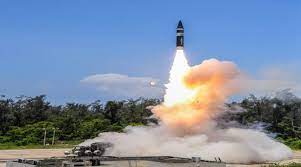On October 3, 1999, the United States conducted a significant test of its anti-ballistic missile (ABM) system. This test, known as the "3 October ABM Test," marked an important milestone in the development and implementation of missile defense technology. The purpose of the test was to evaluate the effectiveness of the ABM system in intercepting and destroying incoming ballistic missiles. The ABM system, also known as a missile defense system, is designed to detect, track, and intercept enemy missiles in order to protect a country from potential missile attacks. The 3 October ABM Test involved the launch of a target missile, simulating a potential threat, from the Kodiak Launch Complex in Alaska. The target missile was designed to replicate the trajectory and characteristics of a long-range ballistic missile. In response, the ABM system deployed interceptor missiles to intercept and destroy the incoming target missile. The success of the 3 October ABM Test was a significant achievement for the United States. It demonstrated the capability of the ABM system to detect, track, and intercept ballistic missiles, thus providing a defense against potential attacks. The test represented a step forward in the development and implementation of missile defense technology, bolstering the country's national security. The test also had broader implications for international relations and strategic defense policies. The development of effective missile defense systems has been a topic of debate among nations, particularly with regards to the balance of power and the potential impact on arms control treaties. The success of the 3 October ABM Test sparked discussions and debates about the feasibility and implications of missile defense systems on global security. The test highlighted the ongoing efforts by the United States to enhance its missile defense capabilities. It demonstrated the country's commitment to developing advanced technologies to counter emerging threats and protect its national interests. The successful interception of the target missile in the 3 October ABM Test provided a level of confidence in the effectiveness of the ABM system and encouraged further investment in missile defense technology. The 3 October ABM Test also served as a catalyst for continued research, development, and refinement of missile defense systems. It provided valuable data and insights into the performance and limitations of the ABM system, allowing scientists and engineers to make improvements and enhancements based on real-world testing. In the years following the 3 October ABM Test, missile defense technology has continued to evolve and advance. The United States, along with other countries, has invested significant resources in the development of more sophisticated and capable missile defense systems. The successful test on October 3, 1999, marked an important milestone in the development of missile defense technology and demonstrated the United States' commitment to enhancing its national security. It showcased the potential of the ABM system to intercept and destroy incoming ballistic missiles, providing a layer of defense against potential threats. The test also stimulated discussions and debates about the role and implications of missile defense systems in international relations and strategic defense policies. The ongoing development and implementation of missile defense technology continue to shape the global security landscape and serve as a crucial component of national defense strategies.
3 Oct, 1999 Anti-ballistic Missile System Tested
